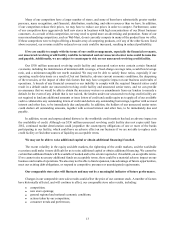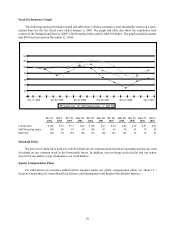Cabela's 2009 Annual Report Download - page 31
Download and view the complete annual report
Please find page 31 of the 2009 Cabela's annual report below. You can navigate through the pages in the report by either clicking on the pages listed below, or by using the keyword search tool below to find specific information within the annual report.22
Recently adopted amendments to accounting standards will require us to consolidate previous and future
securitization transactions, which will have a significant impact on our consolidated financial statements,
and will cause us to reallocate capital from our Retail and Direct businesses to meet the capital needs of our
Financial Services business.
The Financial Accounting Standards Board updated Accounting Standards Codification (“ASC”) Topic 810,
Consolidations, and ASC Topic 860, Transfers and Servicing, which significantly changed the accounting for transfers
of financial assets and the criteria for determining whether to consolidate a variable interest entity (“VIE”). The
update to ASC Topic 860 eliminates the qualifying special purpose entity (“QSPE”) concept, establishes conditions
for reporting a transfer of a portion of a financial asset as a sale, clarifies the financial-asset derecognition criteria,
revises how interests retained by the transferor in a sale of financial assets initially are measured, and removes the
guaranteed mortgage securitization recharacterization provisions. The update to ASC Topic 810 requires reporting
entities to evaluate former QSPEs for consolidation, changes the approach to determining a VIE’s primary beneficiary
from a mainly quantitative assessment to an exclusively qualitative assessment designed to identify a controlling
financial interest, and increases the frequency of required reassessments to determine whether a company is the
primary beneficiary of a VIE. The application of ASC Topics 810 and 860 resulted in the consolidation of the Trust’s
assets and liabilities effective January 3, 2010. The Financial Services business will also be required to establish
allowances for loan losses relating to such assets beginning in fiscal 2010.
We have evaluated the impact that the guidance of ASC Topics 810 and 860 will have on our compliance with the
financial covenants in our credit agreements and unsecured notes and do not believe that these accounting standards,
if they were effective as of January 2, 2010, would have caused us to be in breach of any financial covenants in our
credit agreements and unsecured notes. We can offer no assurances that the impact from the application of these
accounting standards will not cause us to breach financial covenants in our credit agreements and unsecured notes
in the future. In addition, our existing credit agreement limits the amount of capital we can contribute to our bank
subsidiary to $225 million in calendar year 2010 plus up to $25 million in any fiscal year. In November 2009, we
made a $25 million capital contribution to our bank subsidiary.
On January 21, 2010, the Office of the Comptroller of the Currency, the Federal Deposit Insurance Corporation,
the Office of Thrift Supervision, and the Federal Reserve (collectively, the “federal agencies”) issued final rules
entitled Risk-Based Capital Guidelines; Capital Adequacy Guidelines; Capital Maintenance; Regulatory Capital;
Impact of Modifications to Generally Accepted Accounting Principles; Consolidation of Asset-Backed Commercial
Paper Programs; and Other Related Issues relating to changes to regulatory capital as a result of ASC Topics 810
and 860. The Financial Services business will be subject to increased regulatory capital requirements as a result of
consolidating the assets of the Trust. The final rule provides an optional two-quarter delay and subsequent two-
quarter phase-in (for a maximum of one year) for the effect on risk-based capital relating to the assets that must be
consolidated as a result of the change in accounting principles. The final rule provides no ongoing relief for increases
in risk-based capital or leverage capital requirements that will result from assets transferred in connection with
securitizations being brought on balance sheet as a result of the change in generally accepted accounting principles.
As a consequence, no later than December 31, 2010, the Financial Services business will be required to maintain
both risk-based capital and leverage capital against the assets of the Trust, which will require us to contribute
approximately $200 million in additional capital to our bank subsidiary during 2010. This could significantly alter
our growth initiatives. Although our bank subsidiary satisfies the requirements for the well-capitalized classification
under the regulatory framework for prompt corrective action at January 2, 2010, no assurances can be given that
our bank subsidiary will continue to satisfy such requirements. If our bank subsidiary ceases to qualify as well-
capitalized, the bank would become subject to regulatory restrictions that could materially adversely affect its ability
to conduct normal operations, liquidity, and cost of funds.
ASC Topics 810 and 860 may also eliminate our ability to rely on the FDIC’s regulation relating to the
treatment of financial assets transferred in a securitization transaction. In November 2009, the FDIC announced an
interim amendment of this regulation. Under the interim amendment, the legal isolation of property transferred in a
securitization transaction prior to March 31, 2010, is preserved, regardless of whether the transfer qualifies for sale
accounting treatment under new accounting standards if the transfer otherwise complies with the FDIC’s regulation.
On December 15, 2009, the FDIC issued an Advance Notice of Proposed Rulemaking in order to solicit public
























